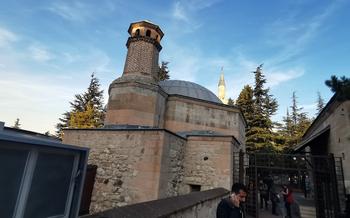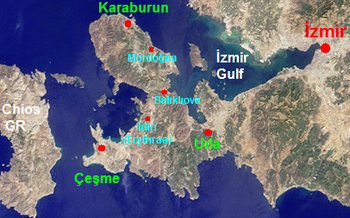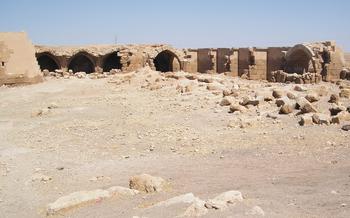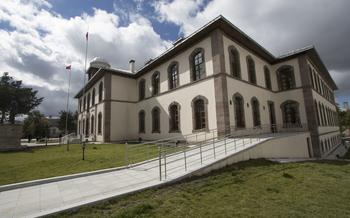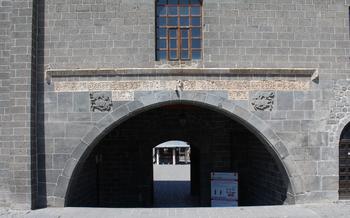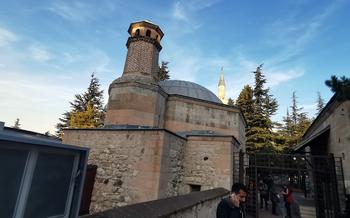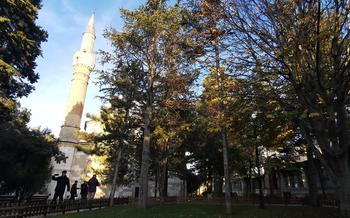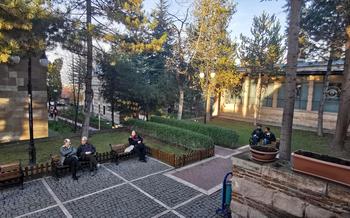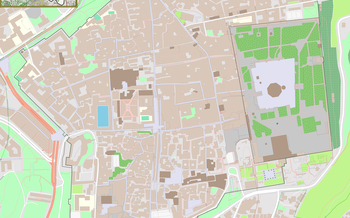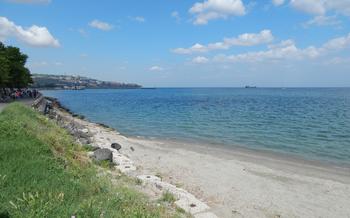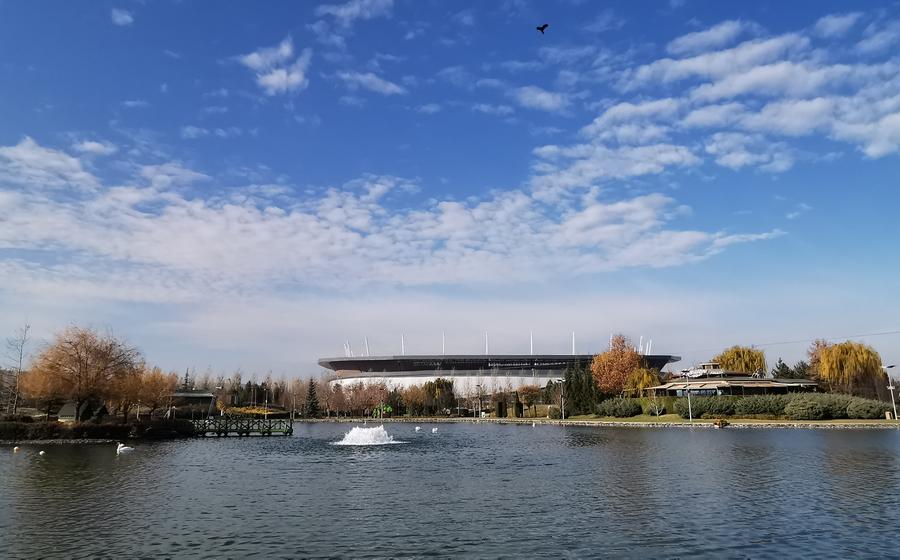
Nasreddin Hodja Archaeology and Ethnography Museum
- About the Nasreddin Hodja Archaeology and Ethnography Museum:
- Exploring the Museum's Collections
- Travel Through History
- Nasreddin Hodja's Legacy
- Traditional Crafts and Customs
- Ethnographic Treasures
- Interactive Learning Experiences
- Temporary Exhibitions and Events
- Guided Tours and Audio Guides
- Souvenirs and Museum Shop
- Accessibility for All
- Educational Resources and Publications
- Surrounding Attractions
- Local Cuisine and Dining Options
- Insider Tip: Unveiling the Hidden Charms of the Museum
About the Nasreddin Hodja Archaeology and Ethnography Museum:
Historical Significance: The Nasreddin Hodja Archaeology and Ethnography Museum stands as a testament to Eskişehir's rich history and cultural heritage. Named after the beloved folk hero and humorist, Nasreddin Hodja, the museum houses a treasure trove of artifacts and exhibits that narrate the city's journey through time.
Location and Accessibility: Ideally situated in the heart of Eskişehir, the museum is easily accessible by public transportation or on foot. Its central location makes it a convenient stop for visitors exploring the city's other attractions.
Architectural Features and Design: Housed in a beautifully restored Ottoman-era building, the museum's architecture seamlessly blends traditional and modern elements. Visitors are greeted by an elegant facade adorned with intricate carvings and arched windows. Inside, the spacious galleries are designed to showcase the museum's collection in a well-organized and visually appealing manner.
Museum Hours and Admission Fees: The Nasreddin Hodja Archaeology and Ethnography Museum welcomes visitors from Tuesday to Sunday, offering extended hours during the summer months. Admission fees are minimal, allowing travelers to enjoy an affordable and enriching cultural experience.
Exploring the Museum's Collections
The Nasreddin Hodja Archaeology and Ethnography Museum houses a diverse range of artifacts and exhibits that provide visitors with a comprehensive overview of Eskişehir's rich history and cultural heritage. Archaeological findings from various periods, including the Neolithic, Bronze, and Iron Ages, offer insights into the ancient civilizations that inhabited the region. These artifacts include pottery, tools, weapons, and jewelry, each shedding light on the daily lives, customs, and artistic expressions of our ancestors.
The museum's ethnographic displays showcase the local culture and traditions of Eskişehir. Visitors can admire intricate textiles, colorful carpets, traditional costumes, and ornate jewelry, all of which reflect the unique craftsmanship and artistry of the region. Interactive exhibits, such as touchscreens and multimedia presentations, engage visitors and provide additional information about the history and significance of the artifacts on display.
Travel Through History
As you wander through the halls of the Nasreddin Hodja Archaeology and Ethnography Museum, you'll embark on a journey through time, discovering the rich tapestry of Eskişehir's past. Unearthed artifacts from various periods paint a vivid picture of the city's evolution, shedding light on the civilizations that have left their mark on this vibrant land.
From prehistoric tools and pottery to intricate jewelry and sculptures, the museum's collection provides a glimpse into the lives of ancient inhabitants. You'll marvel at the craftsmanship and ingenuity of these early artisans, whose creations offer clues to the cultural and technological advancements of their time.
The museum also showcases the influence of diverse empires that have ruled over Eskişehir throughout history. From the Romans to the Byzantines and Ottomans, each civilization has left its unique imprint on the city's architecture, art, and traditions. Through carefully curated exhibits, you'll learn about the political, social, and cultural changes that have shaped Eskişehir into the vibrant metropolis it is today.
Historical context and storytelling are woven into every display, bringing the past to life and allowing visitors to connect with the people who lived and worked in this region centuries ago. Immerse yourself in the tales of ancient battles, royal dynasties, and everyday life, gaining a deeper appreciation for the rich history that lies beneath Eskişehir's modern façade.
Nasreddin Hodja's Legacy
The legendary figure of Nasreddin Hodja is inextricably linked to Eskişehir and Turkish culture. Known for his wit, wisdom, and humorous anecdotes, Nasreddin Hodja's tales have been told and retold for generations. The museum pays homage to this beloved character with a dedicated section showcasing his life and legacy.
Exhibits feature artifacts, illustrations, and interactive displays that bring Nasreddin Hodja's stories to life. Visitors can learn about his mischievous adventures, his encounters with sultans and commoners, and the underlying lessons embedded in his tales. The museum also highlights the cultural significance of Nasreddin Hodja, whose stories have transcended borders and become an integral part of Turkish folklore.
Through these exhibits, visitors gain a deeper understanding of Nasreddin Hodja's enduring impact on Turkish culture and his role as a symbol of humor, wisdom, and the human condition.
Traditional Crafts and Customs
The Nasreddin Hodja Archaeology and Ethnography Museum celebrates the rich cultural heritage of Eskişehir by showcasing a wide range of traditional Turkish handicrafts. These exhibits provide a glimpse into the skills and artistry of local artisans and offer a deeper understanding of the region's unique customs and practices. Visitors can admire intricate textiles, woven with vibrant colors and intricate patterns, that showcase the region's renowned weaving traditions. Ceramic pottery, adorned with delicate designs and intricate motifs, reflects the region's long-standing ceramic heritage. Other artisanal creations, such as hand-crafted jewelry, metalwork, and woodworking, further demonstrate the diverse talents and skills of local craftsmen. These exhibits not only preserve cultural heritage but also provide a valuable opportunity to appreciate the artistry and creativity that thrive in Eskişehir.
Ethnographic Treasures
The Nasreddin Hodja Archaeology and Ethnography Museum dedicates a significant section to ethnographic exhibits, providing a glimpse into the daily life and traditions of Eskişehir's people. These displays showcase traditional costumes, intricate jewelry, and household items, offering visitors a tangible connection to the region's rich cultural heritage.
Elaborately embroidered dresses, adorned with colorful motifs and shimmering embellishments, represent the artistry and craftsmanship of local artisans. Headscarves, turbans, and intricately designed jewelry pieces, crafted from silver and gold, reflect the unique style and adornments worn by Eskişehir's inhabitants throughout history.
Beyond personal adornments, the museum exhibits various household items that shed light on traditional practices and customs. Copperware, pottery, and intricately carved wooden utensils showcase the region's culinary traditions and craftsmanship. Carpets and kilims, woven with vibrant colors and intricate patterns, depict the nomadic heritage of the area and the importance of textile arts in daily life.
The ethnographic section of the museum also features displays depicting rural life and agricultural practices. Tools used for farming, such as plows, sickles, and threshing machines, provide Einblick into the region's agricultural heritage. Visitors can also learn about traditional methods of food preservation, such as pickling, drying, and fermenting, which played a crucial role in sustaining communities during the harsh winter months.
Through these ethnographic displays, the Nasreddin Hodja Archaeology and Ethnography Museum offers visitors a deeper understanding of the local way of life, the customs and practices that have shaped Eskişehir's unique identity, and the enduring legacy of its people.
Interactive Learning Experiences
The Nasreddin Hodja Archaeology and Ethnography Museum offers a variety of interactive learning experiences, making it a great place for visitors of all ages to engage with the past in a fun and memorable way. Hands-on activities, educational programs, and workshops allow visitors to explore the museum's collection in a more immersive and engaging way. These interactive exhibits not only provide opportunities for visitors to learn about Eskişehir's history and culture but also help to promote cultural appreciation and make learning fun.
One of the most popular interactive exhibits is the "Try Your Hand at Archaeology" station, where visitors can use replica tools to excavate simulated archaeological sites and uncover hidden artifacts. This activity provides a hands-on experience of the work that archaeologists do and helps visitors to understand the importance of preserving our cultural heritage.
Another popular interactive exhibit is the "Dress Up Like a Local" station, where visitors can try on traditional Turkish clothing and learn about the different styles of dress that have been worn in Eskişehir throughout history. This activity is a great way to learn about Turkish culture and customs and to see how people dressed in different eras.
The museum also offers a variety of educational programs and workshops for visitors of all ages. These programs cover a wide range of topics, from the history of Eskişehir to the traditional crafts and customs of the region. Workshops are a great way to learn new skills and to gain a deeper understanding of Turkish culture.
Temporary Exhibitions and Events
The Nasreddin Hodja Archaeology and Ethnography Museum is not just about its permanent collection; it also hosts a variety of temporary exhibitions and events throughout the year, offering visitors a fresh and dynamic experience. These exhibitions often focus on specific themes, artists, or historical periods, providing an in-depth exploration of diverse topics related to Eskişehir's culture and heritage.
From contemporary art installations to historical artifacts, the temporary exhibitions at the museum are curated to showcase the works of talented artists, highlight significant events, or delve into specific aspects of local history and traditions. These exhibitions not only add variety to the museum's offerings but also provide a platform for emerging artists and cultural initiatives to showcase their work and connect with a wider audience.
In addition to exhibitions, the museum also organizes cultural events, workshops, and demonstrations that bring the exhibits to life and provide visitors with opportunities to engage with the museum's collection in a more interactive and immersive way. These events may include traditional music performances, craft demonstrations, storytelling sessions, or educational workshops, offering visitors a deeper understanding of Eskişehir's rich cultural heritage.
By hosting temporary exhibitions and events, the Nasreddin Hodja Archaeology and Ethnography Museum stays relevant and engaging, offering visitors a reason to return and explore new perspectives on Eskişehir's past and present. It also contributes to the city's cultural vibrancy and fosters a sense of community and cultural exchange.
Guided Tours and Audio Guides
To enhance visitors' understanding and appreciation of the museum's exhibits, guided tours in various languages are available. Knowledgeable guides lead these tours, providing insightful commentary and historical context, ensuring that visitors gain a comprehensive perspective on the museum's collection.
For those who prefer a self-guided exploration, informative audio guides are offered. These audio guides provide detailed descriptions of the exhibits, allowing visitors to learn at their own pace and focus on specific areas of interest. Whether you choose a guided tour or an audio guide, you'll have the opportunity to delve deeper into the stories behind the artifacts and gain a profound understanding of Eskişehir's rich history and cultural heritage.
Souvenirs and Museum Shop
The Nasreddin Hodja Archaeology and Ethnography Museum offers a unique opportunity to take a piece of Eskişehir home with you. The museum shop is stocked with a wide variety of souvenirs and gifts inspired by the museum's collection. From traditional Turkish handicrafts to replicas of ancient artifacts, there is something for everyone.
Visitors can find a variety of unique and authentic souvenirs to commemorate their visit. These include replicas of ancient coins, pottery, and jewelry, as well as traditional Turkish handicrafts such as carpets, textiles, and ceramics.
By purchasing souvenirs from the museum shop, visitors not only take home a memento of their visit but also support the museum and its mission to preserve cultural heritage. The proceeds from the shop help to fund educational programs, exhibitions, and research, ensuring that the museum can continue to share the rich history and culture of Eskişehir with visitors from around the world.
Accessibility for All
The Nasreddin Hodja Archaeology and Ethnography Museum is committed to providing an inclusive and welcoming environment for all visitors. Visitors with disabilities can enjoy a hassle-free experience thanks to the museum's accessible features. Wheelchair ramps and elevators ensure that all levels of the museum are easily accessible. Adapted tours and materials are available for visually impaired visitors, allowing them to fully immerse themselves in the museum's offerings. The museum's staff is also trained to assist visitors with any special needs, ensuring that everyone has an enriching and enjoyable experience.
Educational Resources and Publications
The Nasreddin Hodja Archaeology and Ethnography Museum boasts a treasure trove of educational resources and publications that delve deeper into the history and culture of Eskişehir. Visitors can purchase books, pamphlets, and educational materials related to museum exhibits and local history, providing opportunities for further learning and research. These publications offer a comprehensive understanding of Eskişehir's rich cultural heritage, allowing visitors to continue their exploration beyond the museum walls. Whether you're a history buff, a cultural enthusiast, or simply seeking to broaden your knowledge, the museum's educational resources provide a gateway to a deeper appreciation of Eskişehir's unique identity.
Surrounding Attractions
After delving into the rich history and culture at the Nasreddin Hodja Archaeology and Ethnography Museum, take the opportunity to explore the surrounding area and discover other hidden gems. Just a short walk away, you'll find the esteemed Porsuk Çayı River, a picturesque waterway lined with lush greenery and historic bridges. Embark on a leisurely stroll along its banks, admiring the scenic views and soaking in the tranquil ambiance.
For a deeper dive into Eskişehir's artistic heritage, head to the nearby Çağdaş Sanatlar Müzesi (Museum of Contemporary Art). This renowned institution showcases an impressive collection of modern and contemporary Turkish art, featuring works from both established and emerging artists. Immerse yourself in the vibrant colors, unique perspectives, and thought-provoking installations that grace its galleries.
To experience the city's vibrant energy, venture into the bustling Odunpazarı district. This historic neighborhood, with its charming Ottoman-era houses, narrow cobblestone streets, and lively atmosphere, offers a glimpse into Eskişehir's past. Browse the local shops for traditional handicrafts, savor delicious Turkish cuisine at one of the many restaurants, or simply soak in the vibrant ambiance of this vibrant district.
By venturing beyond the museum, you'll uncover a wealth of cultural experiences that will further enrich your understanding of Eskişehir's rich history and vibrant contemporary culture.
Local Cuisine and Dining Options
To fully immerse yourself in the local culture, don't miss the opportunity to savor the delicious Turkish cuisine near the Nasreddin Hodja Archaeology and Ethnography Museum. A short walk from the museum, you'll find a variety of restaurants offering traditional dishes that will tantalize your taste buds. Indulge in the succulent flavors of döner kebab, a rotating skewer of marinated meat that is shaved off and served with fresh vegetables and sauces. For a taste of regional cuisine, try keşkek, a hearty dish made from shredded wheat, lamb, and chickpeas, slow-cooked to perfection. Don't forget to accompany your meal with a refreshing glass of ayran, a yogurt-based beverage that perfectly complements the rich flavors of Turkish food.
Insider Tip: Unveiling the Hidden Charms of the Museum
To fully immerse yourself in the treasures of the Nasreddin Hodja Archaeology and Ethnography Museum, consider visiting during the off-season or on weekdays to avoid the rush. This will allow you to leisurely explore the exhibits and engage with the museum staff for a more personalized experience.
Keep an eye out for hidden gems within the museum. In the archaeology section, seek out the intricately carved stone artifacts that tell tales of ancient civilizations. Within the ethnographic displays, discover the intricate details of traditional costumes and jewelry, each piece a testament to the region's rich cultural heritage.
Don't miss the secret spots that offer unique photo opportunities. Capture the essence of the museum's ambiance by photographing the sunlit courtyard, adorned with traditional Turkish motifs. Frame your shots with the museum's striking architecture, ensuring a visually captivating backdrop for your memories.
Unlock the hidden stories behind the exhibits by engaging with the museum's knowledgeable staff. They can provide insights into the significance of artifacts, share anecdotes about Nasreddin Hodja, and recommend lesser-known exhibits that may pique your interest.
By following these insider tips, you'll uncover the hidden treasures of the Nasreddin Hodja Archaeology and Ethnography Museum, creating a truly memorable and enriching experience.
